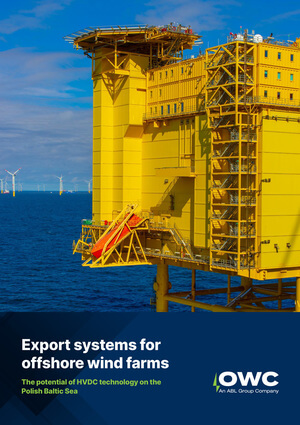OWC encourages HVDC transmission systems considerations for Polish offshore wind farms
Poland has a rapidly developing offshore wind market. There are currently nine projects under development with combined capacity exceeding 8 GW, with first power generation expected in 2025. In addition, there are 11 other offshore wind farm sites waiting to be awarded to the developers competing for them. All these projects may result in around 18 GW of installed offshore wind power.
Contrary to some other markets, in Poland the developer is responsible for the grid connection, including the offshore substation, offshore and onshore export cable and onshore substation, with the grid operator virtually providing the grid capacity and connection point only. The two major types of technology used for generation export are High Voltage Alternated Current (“HVAC”) and High Voltage Direct Current (“HVDC”).
Until recently, HVDC has not often been considered in Poland. However, being aware of worldwide market circumstances and project decisions, OWC encourages developers to conduct more site specific studies to consider HVDC as potential export transmission scheme in connection with Poland’s second seabed leasing round of far offshore wind farms.
“Selection of the transmission system technology of the offshore wind farm export system with associated grid connection application are therefore one of the most important decisions driving the design process of Polish offshore wind farms. It will have a great impact on project performance such as the production, availability, capital and operational costs,” says Bartosz Hunek, principal electrical engineer at OWC and co-author of the white paper.
 HVDC vs HVAC
HVDC vs HVAC
Compared to HVAC, HVDC is able to export much larger capacities with fewer cables and has lower transmission losses over long distances. Therefore, HVDC technology is generally more applicable for the projects of larger capacity and longer cable routes. However, HVDC, due to its complexity, still has considerable costs and supply chain constraints.
In the past years, most of the wind farms were built below that length and were using HVAC. Nonetheless, HVDC is already commonly considered for large and far offshore projects being consented worldwide, and its role in the offshore power export systems is expected to grow.
In its white paper, OWC has conducted an analysis of the main HVDC technology features together with their impact on the offshore wind farm development, construction and operation. OWC has also developed a technical and cost model of the export systems of Polish offshore wind farms, comparing both technologies.
“There are multiple good reasons for developers to consider HVDC technology for Polish wind farms, but they need to be aware that HVDC also brings its own set of challenges. Nevertheless, the main conclusion from our analysis that certain wind farm areas at Polish Baltic Sea may use HVDC export technology and that we encourage more discussion about this subject in the Polish offshore wind market,” says Piotr Jedrzejewski, electrical engineer at OWC and co-author of the white paper.
Presentation of white paper
The whitepaper, titled “Export systems for offshore wind farms: The potential of HVDC technology on the Polish Baltic sea” will be published and available to download via https://abl-group.com/white-papers/ on 28th March 2023.
OWC, which is part of Oslo-listed ABL Group ASA, is a specialist consultancy that helps develop and deliver offshore wind projects and investments for developers and investors in all global markets. The company offers project development services, owner’s engineering and technical due diligence to the offshore renewables sector.
- Source:
- OWC (ABL Group)
- Author:
- Press Office
- Link:
- abl-group.com/...
- Keywords:
- OWC, consultant, Poland, offshore, wind farm, HVDC, transmission system, grid, electricity, power, Baltic Sea, developer, white paper

























